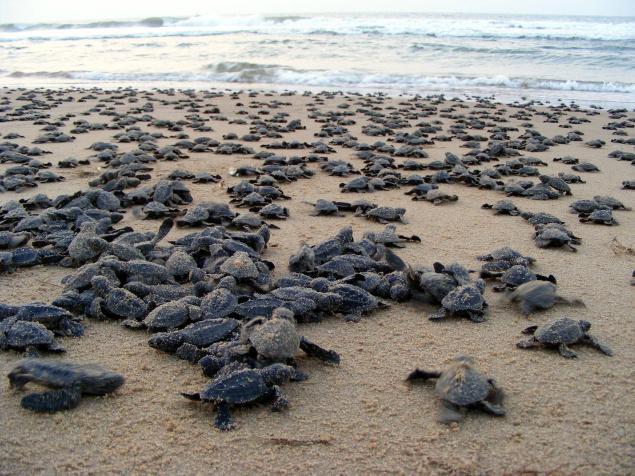
Gahirmatha Beach- Odisha
Considered to be “the world’s most important nesting spot for the Olive Ridley Turtles species” is the Gahirmatha Beach. Situated in Odisha in the Kendrapara district, this scenic beach basically creates a division between the Bhitarkanika mangroves and the Bay of Bengal. Furthermore, this beach also forms a part of the “Gahirmatha Marine Wildlife Sanctuary” as well as of the Bay of Bengal. In addition, this beach is also renowned for its “pristine and picturesque” beauty. It is situated at a distance of about 168 km (via Chandabali Rd)
Read More 6 Popular Beaches in East India

The Olive Ridley Turtles laying eggs at the Gahirmatha Beach in Odisha
a. How to reach Gahirmatha Beach?
[put_wpgm id=11]
Gahirmatha Beach Map
1. By train:
The nearest major railway station located in close proximity to this beach is in Cuttack, situated at a distance of 100 km. The Cuttack railway station is well connected to most major cities in the country.
2. By road:
If you intend to drive to this beach then the ideal starting points would be Bhubaneswar, Cuttack, Puri, Patna, and Kolkata.
a. Via Bhubaneshwar:
There are two routes available and they are via Cuttack-Chandabali Rd which takes about 4 hours and 43 minutes and via NH 16 which takes about 4 hours and 42 minutes.
b. Via Cuttack:
There are three routes available and they are via NH 16, via Cuttack-Chandabali Road which takes 4 hours and 17 minutes, via Cuttack-Chandabali Road which takes 4 hours and 21 minutes, and via NH 16 and SH 35 which takes 5 hours and 20 minutes.
c. Via Puri:
There are two routes available and they are via Badshahi Road and Cuttack Chandabali Road which takes 5 hours and 49 minutes and via SH 60 which takes about 6 hours and 47 minutes.
 d. Via Patna:
d. Via Patna:
There are two routes available and they are via GT Road which takes 19 hours and 21 minutes and via NH 20 which takes 20 hour and 8 minutes.
e. Via Kolkata:
There is one route available and it is via NH 16 which takes about 9 hours 33 minutes.
3. By air:
The closest airport to this beach is located in Bhubaneswar at a distance of about 130 kilometers. The Bhubaneshwar airport is well connected to most of the major cities in India.
Climate and the best time to visit Gahirmatha Beach
The summer season at this beach begins in March and ends in May and comprises of a maximum temperature of about 45 degree Celsius with the mercury dropping to as low as 19 degree Celsius. The rainfall received during the monsoon season which begins in June and ends in September is “moderate”. On the other hand the winter season which begins in December and ends in February is extremely pleasant with the temperature ranging from a maximum of 22 degree Celsius to a minimum of 4 degree Celsius. So, the ideal time to visit this beach is from October to February during winter.
Places To Visit Around Gahirmatha Beach
There are a few spots located around this picturesque beach worth visiting. They are as follows:
1. Gahirmatha Marine Wildlife Sanctuary:
Located on an area of about 1435 square kilometers is the renowned Gahirmatha Marine Wildlife Sanctuary. Situated in close proximity to this beach, this marine sanctuary is popular for the Olive Ridley Sea Turtles species. It apparently has been created to help protect the turtles from being killed. It is one spot that tourist visiting this beach must visit.
2. Sarala Temple:
“Goddess Saraswati” is the primary deity of a Hindu shrine called Sarala Temple situated in close proximity to this beach. Apart from its religious significance, this temple is also worth visiting for its magnificent architecture.
3. Paradip Port:
Located in close proximity to this beach, is the Paradip Port which is considered to be the largest in the country. The picturesque view of its surrounding that it provides for makes it a must visit for tourists.
Interesting facts
This beach is renowned for being the mating nest of the Olive Ridley Turtle species. In fact, according to a report in “The Indian Express” it was in November 2017 that about 20,22,000 baby turtles were hatched at this beach. Furthermore, the Divisional Forest Officer of the Rajnagar Mangrove (Wildlife) Forest Division Bimal Prasanna Acharya explained the mating process of the turtles to the Express by stating that, “The female turtles virtually invade the nesting beaches usually at the dead of the night for laying eggs, the phenomenon otherwise described as “arribada”.
Also Read Offbeat Beaches in India truly worth visiting
Image Credit: eodisha.org








